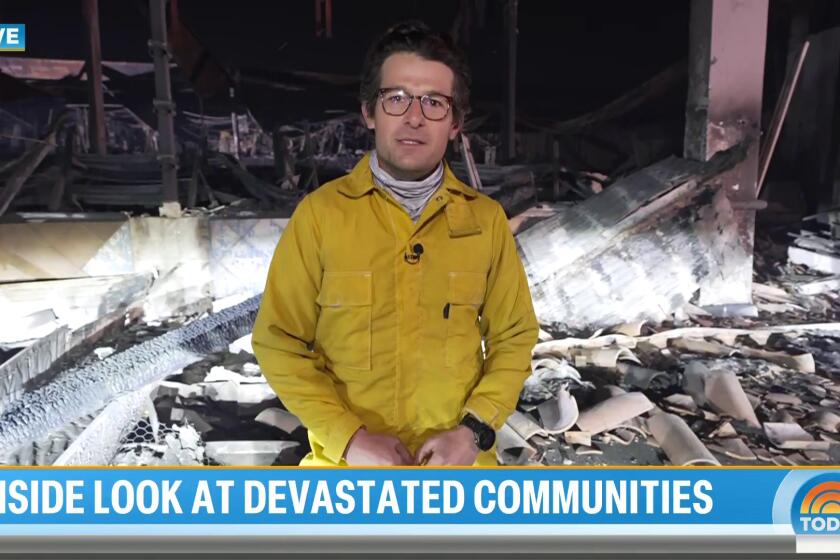The architecturally significant houses destroyed in L.A.’s fires

Los Angeles has Frank Gehry’s glorious Walt Disney Concert Hall, the space-age wonder of the LAX Theme Building and the stack-of-vinyl needle drop that is the Capitol Records building. For some design geeks, however, the heart and soul of L.A.’s architecture resides not just in its museums and office towers but also in its exalted, often otherworldly houses.
Those homes — especially those designed by Midcentury greats such as John Lautner, Richard Neutra, Ray Kappe, and Charles and Ray Eames — have been the obsession of those tracking the threats posed by firestorms laying waste to the wooded canyons and grassy hillsides that are the scenic backdrops for these residences.
Beloved landmarks by Frank Lloyd Wright, Rudolph Schindler and others stand outside of the immediate fire threat, but other notable houses have not been so lucky. Here’s a partial accounting of the confirmed losses:
Zane Grey Estate, Altadena: This home, with elements of Spanish, Mission and Mediterranean Revival design on 1.2 acres west of Lake Avenue, was built by architects Myron Hunt and Elmer Grey in 1907 for Chicago business machine manufacturer Arthur Herbert Woodward. At the time of its construction, it was called the first fire-proof structure in Altadena because it was built of reinforced concrete. (Woodward’s wife had lived through the devastating 1903 Iroquois Theater fire in Chicago, which erupted during a performance, killing more than 600.) The author Zane Grey bought the home in 1920, and he and his wife built a 3,500-square floor addition, including a library and office where Grey used to write. The 7,240-square-foot home was put on the market for about $4 million in 2020 and was listed as having eight bedrooms, four bathrooms, a commercial kitchen with a 15-foot ceiling, as well as a main kitchen, wine cellar and massive basement. Original cast-iron sconces, iron handrails and chandeliers remained in the house, which is on the National Register of Historic Places.
Thirteen deaths have been confirmed and more than 12,000 structures have been damaged or destroyed. Firefighters made more progress on containing the Eaton and Palisades fires overnight, but winds will continue to be a factor throughout the weekend.
The Andrew McNally House: Architect Frederick L. Roehrig built this Queen Anne-style mansion for Rand McNally Publishing Co-founder and President Andrew McNally in 1887. McNally paid Roehrig $15,000 to design the mansion at East Mariposa Street and Santa Rosa Avenue, in an area that would soon be called Millionaire’s Row. The home had a three-story rotunda with views of the San Gabriel Mountains, and McNally kept a private railway car there. He had a gardener who nurtured the deodar cedars along a part of Santa Rosa that became known as Christmas Tree Lane.
The Keeler House: In 1990 modernist architect Ray Kappe remodeled a home for jazz singer Anne Keeler and her then-husband, Gordon Melcher. The 4,142-square-foot cantilevered post-and-beam structure, nestled in a woodsy hillside with canyon and coastline views, went on the market for $12 million in April. With four bedrooms and three bathrooms, the house had walls and floors of concrete complemented by a palette of redwood, teak, fir and glass block. Kappe founded the Southern California Institute of Architecture in 1972 and died in 2019 at age 92.
Janes Village: This cluster of historic English cottages was built between 1924 and 1926 by architect Elisha P. Janes (known professionally as E.P. Janes). Janes built at least 270 English- and Spanish-style cottages in the area. These were mostly single-story stucco-finished homes with six rooms, arranged in one of four floor plans and priced to be accessible to the middle class.
Laura Begley and Evan Dresman had just moved into their dream Gregory Ain home and were preparing to sell their fixer-upper in Altadena’s Janes Village. Fire destroyed both.
Gregory Ain’s Park Planned homes: Designed in 1948 by Ain with the help of the era’s premier modernist landscape architect, Garrett Eckbo, this strip of 28 Midcentury Modern homes was built as part of a social experiment conceived by a modernist architect focused on cost-effective, prefabricated design for working people. The area was created to look like a park with no front fences and continuous landscaping. The homes had side-facing garages and interior courtyards and glass walls, making them feel a bit like mini estates.
Bridges House: Anyone who has driven down Sunset Boulevard toward the coast will remember the Brutalist Bridges House, by architect Robert Bridges. After working on homes including his own, Bridges became a professor of real estate finance at the USC Marshall School of Business, where he is professor emeritus. His striking home was perched above the boulevard, its wood and glass cantilevered over a concrete base.
Will Rogers’ home: The actor’s ranch house, part of Will Rogers State Historic Park, was destroyed in the Palisades fire. In the 1920s Rogers built a 31-room residence with 11 bathrooms, a guesthouse, a golf course, stables and a corral on about 360 acres. In 1944 the compound and grounds became a park and museum after his widow, Betty, donated them to the state. “The Rogers family is devastated by the loss of the California ranch and the overwhelming loss of the community,” Jennifer Rogers-Etcheverry, the actor’s great-granddaughter, said in a statement. “Our hearts go out to all those neighbors who have lost their homes.”
Paris Hilton, Mandy Moore, Jeff Bridges, Mel Gibson and Britney Spears are among the many L.A. County residents affected by the destruction of historic fires.














